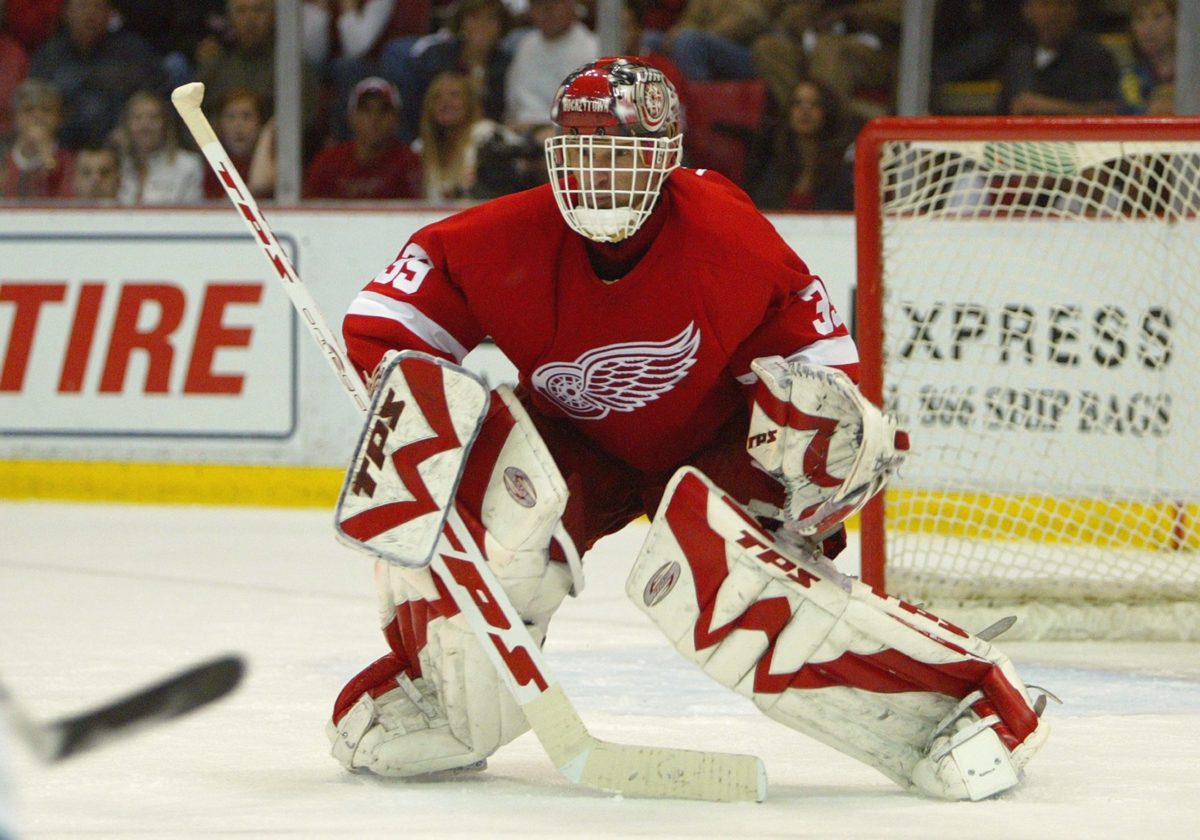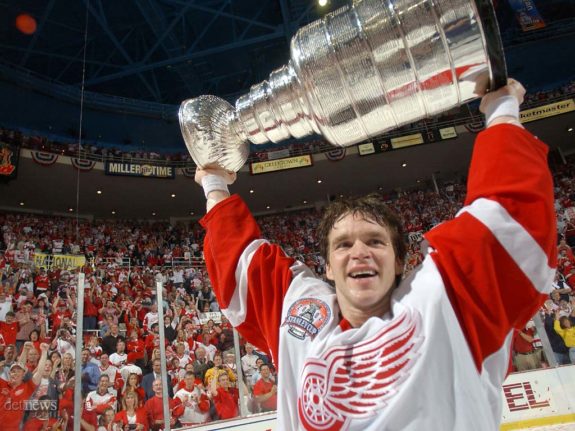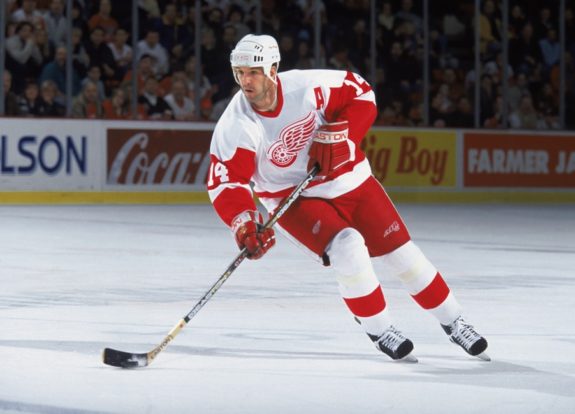Anybody that played Franchise/Be A GM mode in the popular EA Sports NHL series in the mid-2000’s will remember how easy it was to trade your way to an absolutely stacked roster. There was no salary cap, so the player could load up on talent so that they had guys like Brett Hull skating on their third line. Well, in the summer of 2001, real life Detroit Red Wings general manager Ken Holland plugged in his controller and went to work.
The Red Wings were already one of the best teams in the NHL at that point. They had won back-to-back championships in 1997 and 1998, and the core group from those teams remained in tact. They finished either first or second in the Central Division in the three seasons between the 1998 championship and the summer of 2001, but they only won two playoff series during that time. After a somewhat embarrassing first round exit at the hands of the Los Angeles Kings in the 2001 playoffs, Holland decided that his team needed a jolt.
It all started with a change in goal.
Red Wings Bring in “The Dominator”
After years of riding Chris Osgood as their number one guy in goal, the Red Wings and Holland decided that they needed to add a bit more talent in the crease. Luckily for them, the Buffalo Sabres had just been hit with a request from their goaltender to send him to a championship contender. That goaltender was Dominik Hasek, and the ensuing trade sent shockwaves throughout the NHL.
The Red Wings traded Slava Kozlov, a member of the famous “Russian Five” that helped lead Detroit to those championships in the late 90’s, and a first round pick to acquire the then-37-year-old netminder from Czechoslovakia – back when that was a thing. Hasek had just won his sixth Vezina Trophy as the league’s top goaltender, and had already cemented himself as one of the best to ever tend a crease in the NHL. Coincidentally, he also won back-to-back Hart Trophies (awarded to the league MVP) during the same years as Detroit’s back-to-back championships. With the Red Wings during the 2001-02 season, he had 41 wins, five shutouts and a .915 save percentage.

With the net secured, Holland then shifted his attention to the free agent market. These were the days before the salary cap, so teams with deep pockets like the Red Wings were able to throw as much money at a given player as they wanted. With a hole on the left side after trading Kozlov, Detroit’s GM knew he had to add a forward – but he wouldn’t stop at just one.
Reinforcements Up Front
“The one thing I have left to do in my career is to win the Cup, and now I’m going to a team that has that chance,″ “Lucky” Luc Robitaille said during his introductory press conference after signing a two-year deal with the Red Wings. That same press conference is when Detroit formally introduced Hasek as a Red Wing as well. “That’s why I’m the happiest, first they get the ‘Dominator’ and then they get me,″ Robitaille, who played for the same Kings that knocked Detroit out of the playoff earlier that year, said with a smile (From “Luc Robitaille Signs With Red Wings”, AP News, 7/2/01)
Arguably the greatest left winger to ever play the game, Robitaille had already amassed over 1,200 points in the NHL when he signed with the Red Wings. While he was no spring chicken at 35 years old, he brought the same level of credibility to Detroit’s lineup as Hasek did from the goaltending position. Lucky Luc collected 30 goals and 50 points for the Red Wings that season.

But Holland wasn’t done adding yet. With well over 600 goals to his credit at the time, Brett Hull was one of the best pure goal-scorers in the league when he signed a two-year deal with Detroit in August 2001. He would notch 30 goals and 63 points for the Red Wings that season, but it was his role as a mentor for a couple of young players – and one in particular – that paved the way for the Red Wings’ success that season, and many years beyond.
You see, proving that the more things change, the more they stay the same, the 2001-02 season also marked the NHL debut of another talented, young Russian player for the Red Wings. That player was Pavel Datsyuk who, along with Hull and Boyd Devereaux, formed the famous “Two Kids and a Old Goat” line for the Red Wings. That line, paired with the infamous “Grind Line” gave Detroit the kind of bottom six depth that most teams can only dream about having. This season would only tease what was to come for the magical forward, but he brought undeniable skill and playmaking ability to the Red Wings’ lineup in his rookie year, quickly earning the trust of legendary head coach Scotty Bowman.
Dominant Regular Season
The Red Wings brought in Hasek hoping to dominate their competition, and they did. Through the first 27 games of the season, they won 22 of them. While they weren’t able to maintain that unstoppable pace throughout the rest of the season, they did end the season with 51 wins and 116 points. In doing so, they secured the President’s Trophy as the regular season champions. Winger Brendan Shanahan led his team with 37 goals and 75 points; three other Red Wings (Robitaille, Hull and Sergei Fedorov) also scored 30 goals or more.

Despite all their offensive firepower, it was the Red Wings’ top defenseman that was maybe their most impressive player that season, but that was kind of par for the course over Nicklas Lidstrom’s career. With 59 points while averaging just under 29 minutes of ice time a game, “The Perfect Human” secured his second Norris Trophy as the league’s top defenseman that season; he would go on to win the award five more times over the last nine years of his career. However, the Norris wasn’t the only award that he would capture that season….
Despite suffering through a re-aggravated knee injury that would keep him out of 30 games that season, “The Captain” Steve Yzerman was no slouch that season at 36 years old. He had 48 points through 52 games, and carried that production all the way through the playoffs – but we’ll get to those in a minute. As the captain of a team as star-studded as this one, he undoubtedly played a role in helping coach Bowman manage all the different egos that this team contained.
To further capture the scope of talent that was on this roster, I haven’t even mentioned Igor “The Professor” Larionov, Chris Chelios or Tomas Holmstrom, and I’ve barely mentioned Fedorov, who finished second in team scoring with 68 points that season. At any given moment, this team could have upwards of six all-stars on the ice. It’s no wonder the NHL implemented a salary cap just three years later in order to maintain some semblance of competitive balance and parity throughout the league.
2002 Playoffs
All of this might have been for naught had Yzerman not held a player’s only meeting following Game 2 of their opening round matchup against the Vancouver Canucks. With the likes of Markus Naslund, future Red Wing Todd Bertuzzi and goaltender Dan Cloutier, the Canucks won the first two games of this series, casting familiar doubts over whether or not the Red Wings had what it takes to go deep in the playoffs. After that players only meeting, the Red Wings would storm back with four straight wins. Along the way to punching their ticket to the second round, Lidstrom would put Vancouver and the rest of the hockey world on notice with a goal that rattled the Canucks to their core:
After that series with the Canucks, the Red Wings breezed through the second round by defeating the St. Louis Blues in just five games. With eight wins out of 11 games to that point, Detroit was rewarded with a Western Conference Final against their bitter rivals and reigning Stanley Cup champions, the Colorado Avalanche.
This was the fifth playoff matchup between the two teams over the course of seven years. In that time span, the Red Wings had won the Stanley Cup in 1997 and 1998, but the Avalanche had two Cups of their own in 1996 and 2001. Just like in ’97, it only made sense for the Red Wings that the road to the Stanley Cup lead through the reigning champs.
Detroit entered Game 6 in Denver down 3-2 in the series. Prior to the game, Yzerman once again flexed his capabilities as the captain by giving a speech prior to the game that resulted in a clutch performance by him and his teammates. Hasek would play out of his mind, and Avalanche goaltender Patrick Roy would have one of the biggest gaffes of his career:
The Red Wings would win Game 6, returning home for a decisive Game 7. In a series that many would argue was the REAL Stanley Cup Final, the finale could not have gone any better for the supercharged Red Wings. They jumped out to a 4-0 lead after the first period, and Hasek would record his second-straight shutout as Detroit would triumph out their rival with a score of 7-0.
Their final matchup was against the Carolina Hurricanes, who were only in their sixth year of existence after relocating to Raleigh as the former Hartford Whalers. With no disrespect towards the Hurricanes and what they accomplished that season, this Stanley Cup Final was essentially a footnote in the Red Wings’ playoff journey. An empty-net goal from Shanahan on June 13, 2002 sent Hockeytown into celebration as everybody inside Joe Louis Arena knew that Detroit was about to capture their 10th Stanley Cup championship in team history. With his daughter Isabella by his side, Yzerman – who collected 23 points through 23 playoff games – hoisted the Stanley Cup for the third and final time in his career as captain of the Red Wings.
Despite his captain’s heroics throughout the playoffs, it was Lidstrom who was awarded the Conn Smythe as the playoff MVP. Remember, it was his goal from center ice that turned around the Red Wings’ fortunes in the first round; his 16 points through 23 games while averaging over 31 minutes of ice time certainly helped his cause as well.
Greatest Hockey Team of All Time?
It is incredibly hard to assemble a lineup as deep as the 2001-02 Red Wings were. It’s even more difficult to meet expectations once that team is assembled. Just ask the 2018-19 Tampa Bay Lightning who, despite dominating their opponents throughout that season at a rate similar to that legendary Red Wings team, were swept out of the first round that season. Credit Yzerman as well as coach Bowman, who retired from coaching shortly after celebrating this championship.

All-in-all, this team featured 10 members of the Hall of Fame, including their coach who was already a member at the time. When all is said and done, that number could increase to 11 if and when Datsyuk gets the call to the Hall. That figure is something straight out of Backyard Hockey or any other video game where the player can put together an all-star roster with minimal limitations. Except this team was very real, and their names are etched into the Stanley Cup as proof. When a team is this filled with talent and goes on the kind of playoff run that even Hollywood couldn’t script, I think you’re talking about a team that transcends anything a video game could replicate.
I think you’re talking about the greatest team of all time.